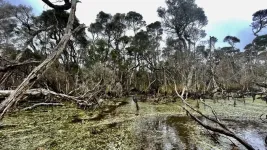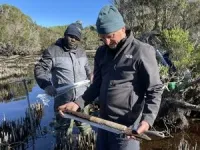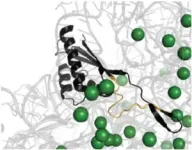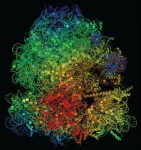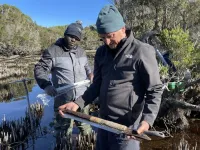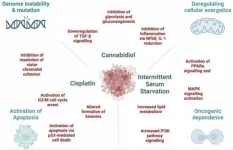(Press-News.org) Some of the first human beings to arrive in Tasmania, over 41,000 years ago, used fire to shape and manage the landscape, about 2,000 years earlier than previously thought.
A team of researchers from the UK and Australia analysed charcoal and pollen contained in ancient mud to determine how Aboriginal Tasmanians shaped their surroundings. This is the earliest record of humans using fire to shape the Tasmanian environment.
Early human migrations from Africa to the southern part of the globe were well underway during the early part of the last ice age – humans reached northern Australia by around 65,000 years ago. When the first Palawa/Pakana (Tasmanian Indigenous) communities eventually reached Tasmania (known to the Palawa people as Lutruwita), it was the furthest south humans had ever settled.
These early Aboriginal communities used fire to penetrate and modify dense, wet forest for their own use – as indicated by a sudden increase in charcoal accumulated in ancient mud 41,600 years ago.
The researchers say their results, reported in the journal Science Advances, could not only help us understand how humans have been shaping the Earth’s environment for tens of thousands of years, but also help understand the long-term Aboriginal-landscape connection, which is vital for landscape management in Australia today.
Tasmania currently lies about 240 kilometres off the southeast Australian coast, separated from the Australian mainland by the Bass Strait. During the last ice age however, Australia and Tasmania were connected by a huge land bridge, which allowed people to reach Tasmania on foot. The land bridge remained until about 8,000 years ago, after the end of the last ice age, when rising sea levels eventually cut Tasmania off from the Australian mainland.
“Australia is home to the world’s oldest Indigenous culture, which has endured for over 50,000 years,” said Dr Matthew Adeleye from Cambridge’s Department of Geography, the study’s lead author. “Earlier studies have shown that Aboriginal communities on the Australian mainland used fire to shape their habitats, but we haven’t had similarly detailed environmental records for Tasmania.”
The researchers studied ancient mud taken from islands in the Bass Strait, which is part of Tasmania today, but would have been part of the land bridge connecting Australia and Tasmania during the last ice age. Due to low sea levels at the time, Palawa/Pakana communities were able to migrate from the Australian mainland.
Analysis of the ancient mud showed a sudden increase in charcoal around 41,600 years ago, followed by a major change in vegetation about 40,000 years ago, as indicated by different types of pollen in the mud.
“This suggests these early inhabitants were clearing forests by burning them, in order to create open spaces for subsistence and perhaps cultural activities,” said Adeleye. “Fire is an important tool, and it would have been used to promote the type of vegetation or landscape that was important to them.”
The researchers say that humans likely learned to use fire to clear and manage forests during their migration across the glacial landscape of Sahul – a palaeocontinent that encompassed modern-day Australia, Tasmania, New Guinea and eastern Indonesia – as part of the extensive migration out of Africa.
“As natural habitats adapted to these controlled burnings, we see the expansion of fire-adapted species such as Eucalyptus, primarily on the wetter, eastern side of the Bass Strait islands,” said Adeleye.
Burning practices are still practiced today by Aboriginal communities in Australia, including for landscape management and cultural activities. However, using this type of burning, known as cultural burning, for managing severe wildfires in Australia remains contentious. The researchers say understanding this ancient land management practice could help define and restore pre-colonial landscapes.
“These early Tasmanian communities were the island’s first land managers,” said Adeleye. “If we’re going to protect Tasmanian and Australian landscapes for future generations, it’s important that we listen to and learn from Indigenous communities who are calling for a greater role in helping to manage Australian landscapes into the future.”
The research was supported in part by the Australian Research Council.
END
Study uncovers earliest evidence of humans using fire to shape the landscape of Tasmania
2024-11-15
ELSE PRESS RELEASES FROM THIS DATE:
Researchers uncover Achilles heel of antibiotic-resistant bacteria
2024-11-15
Recent estimates indicate that deadly antibiotic-resistant infections will rapidly escalate over the next quarter century. More than 1 million people died from drug-resistant infections each year from 1990 to 2021, a recent study reported, with new projections surging to nearly 2 million deaths each year by 2050.
In an effort to counteract this public health crisis, scientists are looking for new solutions inside the intricate mechanics of bacterial infection. A study led by researchers at the University of California San Diego has discovered a vulnerability within strains of bacteria that are antibiotic resistant.
Working with labs at Arizona State University and the Universitat ...
Scientists uncover earliest evidence of fire use to manage Tasmanian landscape
2024-11-15
Some of the first humans to arrive in Tasmania, over 41,000 years ago, used fire to shape and manage the landscape, a new study from The Australian National University (ANU) and the University of Cambridge has found.
It is thought to be the earliest and most detailed record of humans using fire in the Tasmanian environment.
According to the researchers, early inhabitants of Tasmania were managing forests and grasslands by burning them to create open spaces, possibly for food procurement and cultural activities.
The team analysed traces of charcoal and pollen contained in ancient mud that showed how Indigenous Tasmanians (Palawa) ...
Interpreting population mean treatment effects in the Kansas City Cardiomyopathy Questionnaire
2024-11-15
About The Study: Inferences about clinical impacts based on population-level mean treatment effects may be misleading, since even small between-group differences may reflect clinically important treatment benefits for individual patients. Results of this study suggest that clinical trials should explicitly describe the distributions of Kansas City Cardiomyopathy Questionnaire change at the patient level within treatment groups to support the clinical interpretation of their results.
Corresponding ...
Targeting carbohydrate metabolism in colorectal cancer: Synergy of therapies
2024-11-15
“This commentary will discuss what is known about such combinatorial treatments, including potential mechanisms and future protocols.”
BUFFALO, NY- November 15, 2024 – A new review was published in Volume 11 of Oncoscience on November 12, 2024, entitled, “Targeting carbohydrate metabolism in colorectal cancer - synergy between DNA-damaging agents, cannabinoids, and intermittent serum starvation.”
As highlighted by the authors in the abstract of this review, chemotherapy is a common treatment for many cancers. However, it is often ineffective for long-term patient survival and ...
Stress makes mice’s memories less specific
2024-11-15
Stress is a double-edged sword when it comes to memory: stressful or otherwise emotional events are usually more memorable, but stress can also make it harder for us to retrieve memories. In PTSD and generalized anxiety disorder, overgeneralizing aversive memories results in an inability to discriminate between dangerous and safe stimuli. However, until now, it wasn’t clear whether stress played a role in memory generalization.
Now, neuroscientists report November 15 in the Cell Press journal Cell that acute stress prevents mice from forming specific memories. Instead, the stressed mice formed generalized memories, which are ...
Research finds no significant negative impact of repealing a Depression-era law allowing companies to pay workers with disabilities below minimum wage
2024-11-15
PHILADELPHIA—Debate continues to swirl nationally on the fate of a practice born of an 86-year-old federal statute allowing companies to pay workers with disabilities subminimum wages: anything below the federal minimum wage of $7.25 an hour, but for some roles as little as 25-cents-per-hour. Those in favor of repealing this statute highlight assumptions about reduced productivity along with the unfairness of this wage level—often used elsewhere to pay, for example, food service workers who typically make additional wages in tips. Those against repeal have voiced concerns that, without subminimum ...
Resilience index needed to keep us within planet’s ‘safe operating space’
2024-11-15
EMBARGOED: NOT FOR RELEASE UNTIL FRIDAY 15 NOVEMBER 2024 AT 11:00 ET (15:00 UK TIME).
Researchers are calling for a ‘resilience index’ to be used as an indicator of policy success instead of the current focus on GDP.
They say that GDP ignores the wider implications of development and provides no information on our ability to live within our planet’s ‘safe operating space’.
In a paper published today [15 November] in the journal One Earth, researchers from the University of Southampton, UCL ...
How stress is fundamentally changing our memories
2024-11-15
Researchers at The Hospital for Sick Children (SickKids) have uncovered that stress changes how our brain encodes and retrieves aversive memories, and discovered a promising new way to restore appropriate memory specificity in people with post-traumatic stress disorder (PTSD).
If you stumble during a presentation, you might feel stressed the next time you have to present because your brain associates your next presentation with that one poor and aversive experience. This type of stress is tied to one memory. But stress from traumatic events ...
Time in nature benefits children with mental health difficulties: study
2024-11-15
A team of researchers from McGill and Université de Montréal’s Observatoire pour l’éducation et la santé des enfants (OPES, or observatory on children’s health and eduation), led by Sylvana Côté, found that spending two hours a week of class time in a natural environment can reduce emotional distress among 10- to 12-year-olds who had the most significant mental health problems before the program began.
The research comes on the heels of the publication of a UNICEF ...
In vitro model enables study of age-specific responses to COVID mRNA vaccines
2024-11-15
mRNA vaccines saved lives during the COVID-19 pandemic, but older people had less of an immune response to the vaccines than did younger adults. Why? Boston Children’s researchers, led by Byron Brook, PhD, and Ofer Levy, MD, PhD, have found some answers, while providing proof-of-concept of a new system that can model vaccine responses in a dish.
The test system, described in a paper out today in iScience, is called MEMPHIS (Modular Evaluation of immunogenicity using Multi-Platform Human In vitro Systems). It analyzes whole human blood from people of different age groups and applies both proteomics and targeted assays to measure ...
